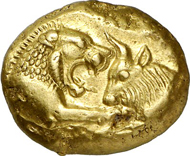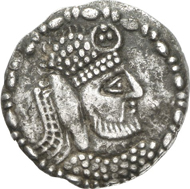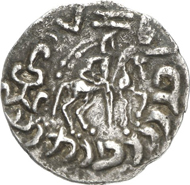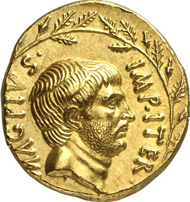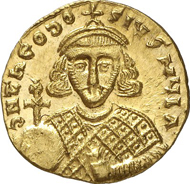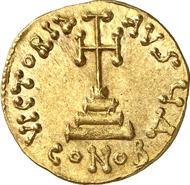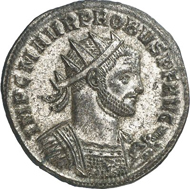14-10-2012 – 16-10-2012
Auctions 207-208: High-quality Ancient Coins; Ancient Coins and Lots
From antiquity right through to the present day – Top prices fetched at Gorny & Mosch: Antiquity sets records
The last years have seen a strong increase in the rush for objects of permanent value. Gorny & Mosch’s most recent auction would seem to attest to just how hot the current climate is for investing in numismatic valuables. Prices were consistently high throughout, whether for ancient or modern coins, premium objects in the six figure range, or even just for ‘normal’ coins valued at just a few hundred Euro.
Auction 207 – High-quality Ancient Coins
Sheer beauty was and still is the overriding criterion by which collectors evaluate Greek coins. It was easy to see this appraisal of beauty at work with two staters of the Amphictyony of Delphi, minted around 346.
No. 219: Amphictyony of Delphi (Phocis). Stater, around 346 BC. Demeter. Rev. Apollo upon an omphalos, sitting facing left. Kinns O1/R5. Very rare. From Gorny & Mosch auction 76 (1996), 134. Extremely fine. Estimate: 25,000 EUR. Final Price: 57,500 EUR.
While the first extremely fine piece featuring the most superb of patinas climbed from its estimate of 25,000 EUR to a much higher 57,500 EUR*, the second, not-so-perfect piece remained at its opening price of 9,200 EUR. The buyer must have been very pleased with himself – he nabbed a real rarity for a more than reasonable price.
No. 366: CROESUS, 561-546 (Lydia). Heavy stater, Sardeis. Carradice 1. Roses 660. Rare. FDC. Estimate: 45,000 EUR. Final Price: 63,250 EUR.
The buyer of the heavy gold stater of Croesus must also have been thrilled with his purchase. For 63,250 EUR, he managed to acquire one of the best-preserved pieces of this incredibly important historical issue (Estimate: 45,000 EUR).
Also particularly impressive was the interest expressed for the rulers of the Middle East, led by a drachm of the Cappadocian king, Ariarathes I. The piece sold for 10,925 EUR, a significant increase from its estimate of 4,000. Things went much the same for a perfect tetradrachm of Antiochus II Theos – the extremely fine piece went for 10,350 EUR (Estimate: 4,000 EUR). And yet, even pieces that weren’t all that rare fetched top prices, so long as the condition passed muster. Take, for example, the final price for a common, but perfect tetradrachm from Demetrius I with high relief – estimated at just 500 EUR, it sold for 2,070 EUR.
No. 453: BIVASAR, ca. 300-350 (Afrighid / Chorasmia). Drachm. Bust of the ruler. Rev. Horseman. Vainberg type B 2 VII, Tf. XVIII (this specimen). Extremely rare. Unicum. Very fine. Estimate: 1,600 EUR. Final Price: 10,925 EUR.
Seeing as the Middle and Far East are steadily attracting more and more interest, the price realized by a unique drachm of Bivasar, a ruler of the Afrighids who reigned in Chorasmia around 300-350, came as no surprise. The piece, estimated at 1,600 EUR, sold for an impressive 10,925 EUR.
As astonishing as these other prices were, the real surprises were yet to come with the Roman coins. Roman gold in outstanding condition is currently bringing in incredible amounts.
No. 546. SEXTUS POMPEIUS MAGNUS PIUS (Roman Republic). Aureus, Sicily. Head of Sextus Pompeius. Rev. Head of his father, Gnaeus Pompeius, across from him, the head of his brother. Cr. 511/1. Very rare. Ex Naville, Lucerne 18.-20.6.1925, 174 (Slg. H. C. Levis). Extremely fine to FDC. Estimate: 40,000 EUR. Final Price: 161,000 EUR.
Take, if you will, the portrait aureus of Sextus Pompeius, which brought in an amazing 161,000 EUR, far eclipsing its estimate of 40,000 and becoming the most expensive piece of the entire auction. The piece of Empress Matidia, carrying the same estimate, was forced to concede defeat with a final price of ‘just’ 126,500 EUR. The extremely fine aureus of Pertinax from a 1965 Hess Auction changed hands for 63,250 EUR (Estimate: 20,000 EUR), and a perfect aureus of Nero sold for 46,000 (Estimate: 15,000 EUR).
No. 829: THEODOSIUS III, 715-717. Solidus. MIB 1. DOC 1. Füeg 1.B.4. FDC. Estimate: 3,500 EUR. Final Price: 9,315 EUR.
The Byzantine pieces were, of course, also good for an impressively high price or two. A solidus of Theodosius III, for example, climbed from an estimate of 3,500 all the way to 9,315 EUR.
The Oberländer Collection of electrum fractions ranging from the 1/192 stater to the stater brought things back down slightly, offering something for the collectors of more modest means. Although, even here, quite a few customers spent more than expected for some items, such as for an early electrum stater from Miletus. The rare, very fine variety changed hands for 8,050 EUR (Estimate: 1,500 EUR).
Auction 208 – Ancient Coins and Lots
In order to sum up the outcome of the second auction, it’s important to emphasize that great increases were once again recorded just in the long-neglected mid-range segment. The pieces in the auction were estimated at 600,000 EUR. Overall final sale prices were closer to 740,000 EUR.
Collectors with specialized knowledge and particular historical interest really flocked to the Roman coins. Here, a denarius of Brutus featuring the inscription EID MAR – pierced, subaerati, an unofficial issue and very fine at best – still brought in an impressive 4,370 EUR instead of its estimated 1,200.
No. 2232: PROBUS, 276-282. Antoninianus, Siscia, 277. Rev. Emperor and Concordia clasping hands. RIC 650. Extremely fine. Estimate: 100 EUR. Final Price: 1,725 EUR.
For the specialty collector, two other prices beg mentioning here: an extremely fine antoninianus of Probus climbed all the way from 100 EUR to 1,725 EUR, and a 40 nummi piece of the Heraclii, minted in 610 in Alexandria, went all the way up from 400 EUR to 1,610 EUR.
Catalogues and prices realized can be found online.
The consignment deadline for the upcoming March auction is December 21, 2012. Full details available at Gorny & Mosch, Giessener Münzhandlung, Maximiliansplatz 20, D-80333 Munich, Tel. +49 / (0)89 / 24 22 643-0, Fax +49 / (0)89 / 22 85 513.
* All prices realized include a 15% buyer’s premium.






